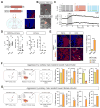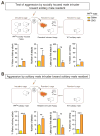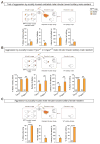Social Control of Hypothalamus-Mediated Male Aggression
- PMID: 28757304
- PMCID: PMC5648542
- DOI: 10.1016/j.neuron.2017.06.046
Social Control of Hypothalamus-Mediated Male Aggression
Erratum in
-
Social Control of Hypothalamus-Mediated Male Aggression.Neuron. 2024 Jun 5;112(11):1892. doi: 10.1016/j.neuron.2024.05.010. Epub 2024 May 16. Neuron. 2024. PMID: 38759640 Free PMC article. No abstract available.
Abstract
How environmental and physiological signals interact to influence neural circuits underlying developmentally programmed social interactions such as male territorial aggression is poorly understood. We have tested the influence of sensory cues, social context, and sex hormones on progesterone receptor (PR)-expressing neurons in the ventromedial hypothalamus (VMH) that are critical for male territorial aggression. We find that these neurons can drive aggressive displays in solitary males independent of pheromonal input, gonadal hormones, opponents, or social context. By contrast, these neurons cannot elicit aggression in socially housed males that intrude in another male's territory unless their pheromone-sensing is disabled. This modulation of aggression cannot be accounted for by linear integration of environmental and physiological signals. Together, our studies suggest that fundamentally non-linear computations enable social context to exert a dominant influence on developmentally hard-wired hypothalamus-mediated male territorial aggression.
Keywords: VMH; aggression; castration; emotion; pheromone; progesterone receptor; sex hormones; sexual dimorphism; territorial behavior; ventromedial hypothalamus.
Copyright © 2017 Elsevier Inc. All rights reserved.
Figures







References
-
- Beeman EA. The effect of male hormone on aggressive behavior in mice. Physiol Zool. 1947;20:373–405. - PubMed
-
- Berry RJ, Bronson FH. Life history and bioeconomy of the house mouse. Biol Rev Camb Philos Soc. 1992;67:519–550. - PubMed
-
- Bishop CM. Neural networks for pattern recognition. Oxford university press; 1995.
MeSH terms
Substances
Grants and funding
LinkOut - more resources
Full Text Sources
Other Literature Sources
Molecular Biology Databases
Research Materials

